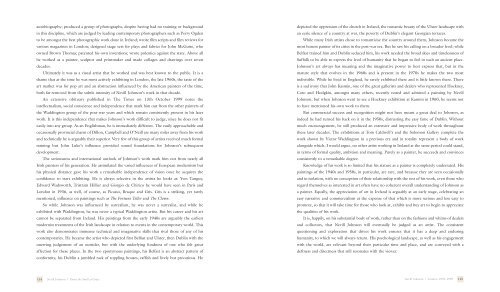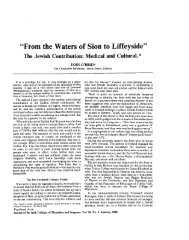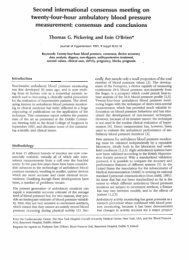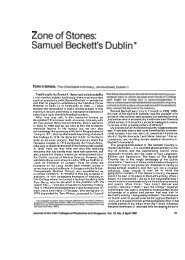Nevill Johnson: Paint the smell of grass - Eoin O'Brien
Nevill Johnson: Paint the smell of grass - Eoin O'Brien
Nevill Johnson: Paint the smell of grass - Eoin O'Brien
You also want an ePaper? Increase the reach of your titles
YUMPU automatically turns print PDFs into web optimized ePapers that Google loves.
autobiography; produced a group <strong>of</strong> photographs, despite having had no training or background<br />
in this discipline, which are judged by leading contemporary photographers such as Perry Ogden<br />
to be amongst <strong>the</strong> best photographic work done in Ireland; wrote film scripts and film reviews for<br />
various magazines in London; designed stage sets for plays and fabrics for John McGuire, who<br />
owned Brown Thomas; patented his own inventions; wrote polemics against <strong>the</strong> state. Above all<br />
he worked as a painter, sculptor and printmaker and made collages and drawings over seven<br />
decades.<br />
Ultimately it was as a visual artist that he worked and was best known to <strong>the</strong> public. It is a<br />
shame that at <strong>the</strong> time he was most actively exhibiting in London, <strong>the</strong> late 1960s, <strong>the</strong> taste <strong>of</strong> <strong>the</strong><br />
art market was for pop art and an abstraction influenced by <strong>the</strong> American painters <strong>of</strong> <strong>the</strong> time,<br />
both far removed from <strong>the</strong> subtle intensity <strong>of</strong> <strong>Nevill</strong> <strong>Johnson</strong>’s work in that decade.<br />
An extensive obituary published in The Times on 13th October 1999 notes <strong>the</strong><br />
intellectualism, social conscience and independence that mark him out from <strong>the</strong> o<strong>the</strong>r painters <strong>of</strong><br />
<strong>the</strong> Waddington group <strong>of</strong> <strong>the</strong> post-war years and which remain consistently present in his later<br />
work. It is this independence that makes <strong>Johnson</strong>’s work difficult to judge, since he does not fit<br />
easily into any group. As an Englishman, he is immediately different. The easily approachable and<br />
occasionally provincial charm <strong>of</strong> Dillon, Campbell and O’Neill are many miles away from his work<br />
and technically he is arguably <strong>the</strong>ir superior. Very few <strong>of</strong> this group <strong>of</strong> artists received much formal<br />
training but John Luke’s influence provided sound foundations for <strong>Johnson</strong>’s subsequent<br />
development.<br />
The seriousness and international outlook <strong>of</strong> <strong>Johnson</strong>’s work mark him out from nearly all<br />
Irish painters <strong>of</strong> his generation. He assimilated <strong>the</strong> varied influences <strong>of</strong> European modernism but<br />
his physical distance gave his work a remarkable independence <strong>of</strong> vision once he acquires <strong>the</strong><br />
confidence to start exhibiting. He is always selective in <strong>the</strong> artists he looks at: Yves Tanguy,<br />
Edward Wadsworth, Tristram Hillier and Giorgio de Chirico he would have seen in Paris and<br />
London in 1936, as well, <strong>of</strong> course, as Picasso, Braque and Gris. Gris is a striking, yet rarely<br />
mentioned, influence on paintings such as The Fortune Teller and The Clown.<br />
So while <strong>Johnson</strong> was influenced by surrealism, he was never a surrealist, and while he<br />
exhibited with Waddington, he was never a typical Waddington artist. But his career and his art<br />
cannot be separated from Ireland. His paintings from <strong>the</strong> early 1940s are arguably <strong>the</strong> earliest<br />
modernist treatments <strong>of</strong> <strong>the</strong> Irish landscape in relation to events in <strong>the</strong> contemporary world. This<br />
work also demonstrates immense technical and imaginative skills that rival those <strong>of</strong> any <strong>of</strong> his<br />
contemporaries. He became <strong>the</strong> artist who depicted first Belfast and Ulster, <strong>the</strong>n Dublin with <strong>the</strong><br />
unerring judgement <strong>of</strong> an outsider, but with <strong>the</strong> underlying fondness <strong>of</strong> one who felt great<br />
affection for <strong>the</strong>se places. In <strong>the</strong> two eponymous paintings, his Belfast is an abstract pattern <strong>of</strong><br />
conformity, his Dublin a jumbled rack <strong>of</strong> toppling houses, raffish and lively but precarious. He<br />
114 <strong>Nevill</strong> <strong>Johnson</strong> l <strong>Paint</strong> <strong>the</strong> Smell <strong>of</strong> Grass<br />
depicted <strong>the</strong> oppression <strong>of</strong> <strong>the</strong> church in Ireland, <strong>the</strong> romantic beauty <strong>of</strong> <strong>the</strong> Ulster landscape with<br />
an eerie silence <strong>of</strong> a country at war, <strong>the</strong> poverty <strong>of</strong> Dublin’s elegant Georgian terraces.<br />
While many Irish artists chose to romanticise <strong>the</strong> country around <strong>the</strong>m, <strong>Johnson</strong> became <strong>the</strong><br />
most honest painter <strong>of</strong> its cities in <strong>the</strong> post-war era. But he saw his calling on a broader level; while<br />
Belfast trained him and Dublin seduced him, his work needed <strong>the</strong> broad skies and timelessness <strong>of</strong><br />
Suffolk to be able to express <strong>the</strong> level <strong>of</strong> humanity that he began to feel in such an ancient place.<br />
<strong>Johnson</strong>’s art always has meaning and <strong>the</strong> imaginative power to best express that, but in <strong>the</strong><br />
mature style that evolves in <strong>the</strong> 1960s and is present in <strong>the</strong> 1970s he makes <strong>the</strong> two most<br />
indivisible. While he lived in England, he rarely exhibited <strong>the</strong>re and is little known <strong>the</strong>re. There<br />
is a sad irony that John Kasmin, one <strong>of</strong> <strong>the</strong> great gallerists and dealers who represented Hockney,<br />
Caro and Hodgkin, amongst many o<strong>the</strong>rs, recently noted and admired a painting by <strong>Nevill</strong><br />
<strong>Johnson</strong>, but when <strong>Johnson</strong> went to see a Hockney exhibition at Kasmin in 1960, he seems not<br />
to have mentioned his own work to <strong>the</strong>m.<br />
But commercial success and recognition might not have meant a great deal to <strong>Johnson</strong>, as<br />
indeed he had turned his back on it in <strong>the</strong> 1950s, distrusting <strong>the</strong> easy fame <strong>of</strong> Dublin. Without<br />
much encouragement, he still produced an extensive and impressive body <strong>of</strong> work throughout<br />
<strong>the</strong>se later decades. The exhibitions at Tom Caldwell’s and <strong>the</strong> Solomon Gallery complete <strong>the</strong><br />
work shown by Victor Waddington in a previous era and in totality represent a body <strong>of</strong> work<br />
alongside which, I would argue, no o<strong>the</strong>r artist working in Ireland at <strong>the</strong> same period could stand,<br />
in terms <strong>of</strong> formal quality, ambition and meaning. Purely as a painter, he succeeds and convinces<br />
consistently to a remarkable degree.<br />
Knowledge <strong>of</strong> his work is so limited that his stature as a painter is completely underrated. His<br />
paintings <strong>of</strong> <strong>the</strong> 1940s and 1950s, in particular, are rare, and because <strong>the</strong>y are seen occasionally<br />
and in isolation, with no conception <strong>of</strong> <strong>the</strong>ir relationship with <strong>the</strong> rest <strong>of</strong> his work, even those who<br />
regard <strong>the</strong>mselves as interested in art <strong>of</strong>ten have no coherent overall understanding <strong>of</strong> <strong>Johnson</strong> as<br />
a painter. Equally, <strong>the</strong> appreciation <strong>of</strong> art in Ireland is arguably at an early stage, celebrating an<br />
easy narrative and commercialism at <strong>the</strong> expense <strong>of</strong> that which is more serious and less easy to<br />
promote, so that it will take time for those who look at, exhibit and buy art to begin to appreciate<br />
<strong>the</strong> qualities <strong>of</strong> his work.<br />
It is, happily, on his substantial body <strong>of</strong> work, ra<strong>the</strong>r than on <strong>the</strong> fashions and whims <strong>of</strong> dealers<br />
and collectors, that <strong>Nevill</strong> <strong>Johnson</strong> will eventually be judged as an artist. The consistent<br />
questioning and exploration that drives his work ensures that it has a deep and enduring<br />
humanity, to which we will always return. His psychological landscape, as well as his engagement<br />
with <strong>the</strong> world, are relevant beyond <strong>the</strong>ir particular time and place, and are conveyed with a<br />
deftness and directness that still resonates with <strong>the</strong> viewer.<br />
<strong>Nevill</strong> <strong>Johnson</strong> l London 1978–1999 115









